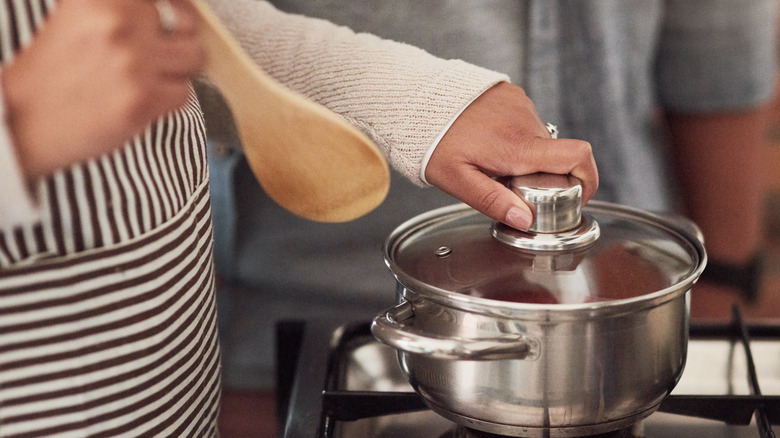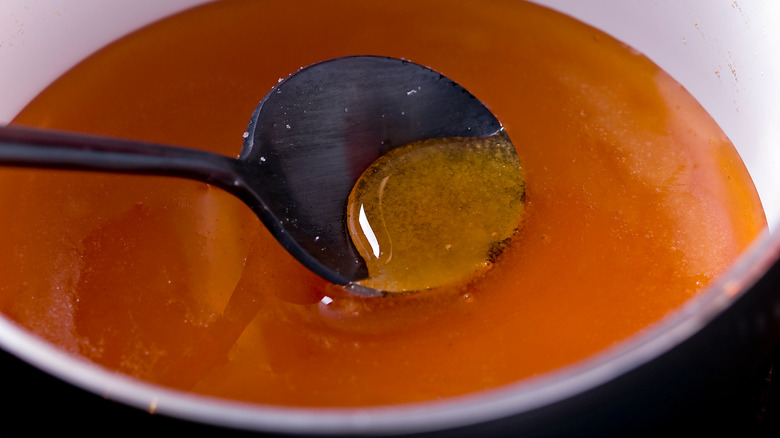Carla Hall's Foolproof Tip For Better Homemade Caramel
Caramel is the very epitome of indulgence. The lusciously sweet confection is pure melted sugar often blended with butter, heavy cream, and an optional pinch of salt to achieve the desired taste and texture. Many enjoy the buttery snack in chewy candy form, but it also makes for an equally tasty dessert topping when drizzled atop ice cream sundaes, apples, popcorn, and the like.
The only downside to this rich, gooey sauce is that it can be tricky to make. For starters, you're not supposed to stir it because sugar can splash onto the sides of your pan and crystallize. Moreover, if you're not careful, the sugar can easily burn, making for a rather unpleasant taste. Fortunately, Carla Hall has cracked the code to making the perfect batch of homemade caramel — and no, it doesn't involve using any expensive pans or fancy equipment like thermometers. According to the celebrity chef, all you need to use is a glass lid.
Opting for a see-through lid accomplishes two things at once: It helps trap steam, drenching your sugary mix with much-needed moisture so it doesn't harden. Plus, the topper will help you keep tabs on the color of your caramel as it cooks — so you can better avoid having to clean burnt sugar from your pots and pans.
The lid traps steam to prevent crystallization
Sucrose, more commonly known as sugar, can be a real pain to work with, namely because it can easily crystallize. In regards to caramel sauce, this can happen when there's not enough water. Any sugar that dries on the sides of your pan can also crystallize and fall back into your mixture. Although still edible, the chunks of sugar can leave your caramel with an undesirable gritty or grainy texture. That's where the lid comes in.
Although some caramel recipes may recommend brushing the sides of your pot or pan with a bit of water, according to Hall, the lid will do the trick just fine. She told People, "The steam washes the sides of the pan to keep the sugar from crystallizing." The added moisture from the steam will help prevent your caramel from becoming too thick or hard, so your salted caramel spread can achieve the desired consistency.
However, you can also combat crystallized sugars by mixing in an inverted sugar, such as honey or corn syrup, which contains glucose and fructose. Since sucrose is made of these two monosaccharides(aka single sugar molecules), adding in more of them can make it difficult for large crystals of sucrose to form. In much the same way, acids like lemon juice or cream of tartar can also help break down the sucrose and keep crystals at bay.
The glass lid will help you achieve the perfect color, too
The color of caramel is equally important, so being able to watch your sugary treat cook is essential. As the sugar mixture heats up, it transforms from a pale yellow to deep amber and then to dark brown via a process known as caramelization. As the heated sugars degrade, oxidation occurs, which causes the caramel — or any food high in sugar such as onions and sweet fruits like bananas and figs — to brown and develop richer flavors. You'll be able to better monitor this process thanks to the glass lid.
The longer the caramel concoction cooks, the darker it becomes and the deeper the heady notes will be. If it's not cooked long enough and the caramel is too light, there may not be much flavor. On the other hand, if you cook the sugar too long, it will greatly lose its sweetness and taste too bitter. Cooking it until it achieves a rich amber color is the sweet spot.
Of course, if you like your caramel more on the bitter side, then by all means, heat your sugar until it's on the brink of burning. However, if you enjoy a more bittersweet flavor, be sure to keep an eye on your caramel via the glass lid and add in your fats once the sugar has reached the desired amber color. With Hall's simple yet effective tip, you'll never have to tuck into subpar homemade caramel again.



